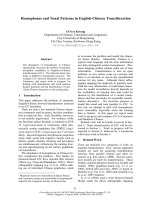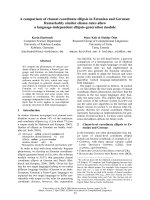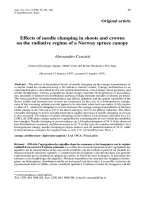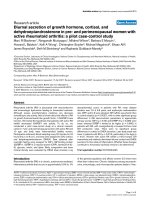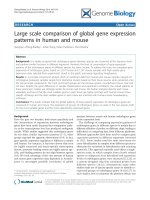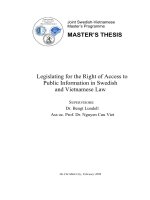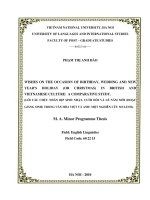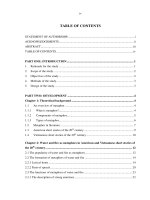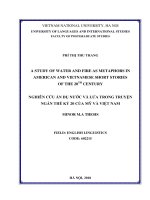Basic sentence patterns in English and Vietnamese
Bạn đang xem bản rút gọn của tài liệu. Xem và tải ngay bản đầy đủ của tài liệu tại đây (140.18 KB, 15 trang )
HO CHI MINH CITY UNIVERSITY OF EDUCATION
DEPARTMENT OF ENGLISH
Basic sentence patterns
in English and Vietnamese
Instructor : Nguyen Ngoc Vu
Student : Nguyen Thi Ai Thu
HCMC, 30/12/2009
Basic sentence patterns
in English and Vietnamese
A contrast analysis
“I give to him some sweets. (Tôi cho nó mấy cái kẹo)”
This sentence above extracted from a Vietnamese student’s translating
Vietnamese sentence into English. Why did this student make errors? In dealing with
learners’ errors, Lado states “since the learner tends to transfer the habits of his native
language structure to the foreign language, we have here the major source of difficulty
or ease in learning the structure of a foreign language. Those structures that are similar
will be easy to learn because they will be transferred and may function satisfactorily in
the foreign language. Those structures that are different will be difficult because when
transferred they will not function satisfactorily in the foreign language and will therefore
have to be changed.”
Vietnamese students usually make errors when translating Vietnamese sentence
into English because there are some differences between Vietnamese and English
grammar. This paper will focus on these differences and classify some error types that
students often meet.
2
In the first part of this paper, we will discuss types of the basic sentence patterns
in English and Vietnamese and make comparison between English and Vietnamese to
find out whether Vietnamese has the same basic sentence patterns or not.
The second part focuses on some errors types that students often meet and how
to conduct teaching translating Vietnamese sentence into English.
Before we explore the basic sentence patterns in English and Vietnamese, it is
important to understand definition of the sentence, element of the sentence and their
functions. Traditional grammar defines that a sentence is ‘a group of words expressing
a complete thought’ or ‘a group of words that begins with a capital letter and ends with a
period’. Vietnamese and English sentence have two main elements: subject and
predicate. Lynnm Berk defines that “the grammatical subject of the sentence is often the
conversational subject, i.e, the person or thing that the sentence is about. The predicate
often makes a comment about that subject, i.e, it ‘predicate’ “. We often see that in a
simple sentence, a subject is a single structure, while a predicate can have internal
structure.
Subject predicate
The child slept
The child threw the ball
His mother considers him quite handsome
3
The predicate must contain a verb and can contain other structure such as a
direct object, an indirect object, various complement structures, and adverbs. In other
words, there are different elements with different functions in the sentence. According to
“A university Grammar of English” there are five elements in English sentence, including
subject(S), verb (V), object (O), complement(C), adjunct (A). According to “Thành phần
câu Tiếng Việt”, there are seven elements in Vietnamese sentence, including Subject-
chủ ngữ(C), verb(V), object-bổ ngữ (B), theme-complement- khởi ngữ( K), disjunct- tình
thái ngữ(T), định ngữ- complement (Đ), trạng ngữ - adverbial(Tr).
In general, English and Vietnamese have the same elements: subject, verb,
object, adjunct (adverbial) and complement. But in Vietnamese has two elements that
has not in English. They are theme complement (khởi ngữ) and disjunct (tình thái ngữ).
Every element may play different functions in sentences. Now we will step by step
analyze each element’s function in detail.
Subject
In English, a subject is normally a noun phrase or any word classes that function
as a noun phrases and always precedes the verb in the sentence. In Vietnamese, the
subject has two types: the subject that co-occurs with verb and the subject that co-
occurs with copulas là. In first type, the subject can be a noun (Cầu sập) or a noun that
show person’s parts of body (Chân anh ta gẫy rồi), pronoun (chúng nó đi học) and
“subject-verb structure” (Nhà cháy làm bị thương hai người). In this type, the subject
always precedes the verb in sentence. The second type, the subject can be a noun (Ba
là sinh viên), a verb (Học tập là nhiệm vụ chính) or a pronoun (Họ là công nhân). In this
type, the subject can change its position.
4
In short, the subject in Vietnamese and English sentence has both similarities
and differences. Similarly, the subject is a noun, pronoun, noun phrases and always
precedes the verb in the sentence. However, in Vietnamese, the subject can co-occur
with copulas là and can changes its position. In addition, subject in Vietnamese
sentence can be “subject-verb structure”
Verb
In English, verb is the main part of verb phrase and always combines with tense
in the sentence. Verb can be intransitive verb, transitive verb or state verb/state of being
verb. In Vietnamese, there are three types of verb. First, verb combines directly with the
subject that does not need copula in the affirmative and negative form (Tôi đọc sách/Tôi
không đọc sách). Second, verb combines with the subject that has copula in the
affirmative and negative form (Tôi là sinh viên/Tôi không phải là sinh viên). Third, in the
affirmative form verb combines directly with the subject, but in the negative form it
combines the subject that have copula (Anh ấy 30 tuổi/Anh ấy không phải 30 tuổi).
The conclusion here is that the verb in Vietnamese and English sentence is
different. In my opinion, the verb in English sentence is more complex than in
Vietnamese because we must distinguish intransitive verb, transitive verb and state
verb. Verbs that can be followed by direct objects are considered transitive. The
intransitive verb is not followed by a direct object (or an indirect object) although it is
often followed by adverbs that express time or place.
Object
5
In English, object is a noun phrase or a prepositional phrase. Some sentences
have two objects, named direct (D.O) and indirect object (I.O) or sometimes object 1
and object 2. The indirect object normally refers to a person (more particularly the
person who is recipient or who benefits from the action). In Vietnamese, Object can be
a noun or noun phrase (Thợ may may áo), verb or verb phrase (Cụ tôi muốn về/Sinh
viên thích chơi trò chơi điện tử) or a “subject-verb structure” (Thầy giáo hi vọng mọi học
sinh đều thành đạt). Some Vietnamese sentences also have two objects: direct and
indirect object. To classify direct object and indirect object, we indicate whether the
object combines preposition or not.
Cô ta gởi thư(direct object) cho mẹ( indirect object)
“mẹ” is direct object because “mẹ” combines with preposition “ cho”
Paraphrase: cô ta gởi mẹ một bức thư
In short, the object in Vietnamese and English sentence also both has similarities
and differences. It can be a noun or a noun phrase. However, in Vietnamese, the object
can be verb, verb phrase or a “subject-verb structure”.
Complement
In English, complement is a noun phrase or an adjective phrase (Jim has
become a qualified engineer). In Vietnamese, complement is second component in the
sentence. It can place before the sentence or between subject and predicate. (Đ ột
nhiên cậu ta nảy ý định bỏ học/ Cậu ta đột nhiên nảy ra ý định bỏ học)
6

